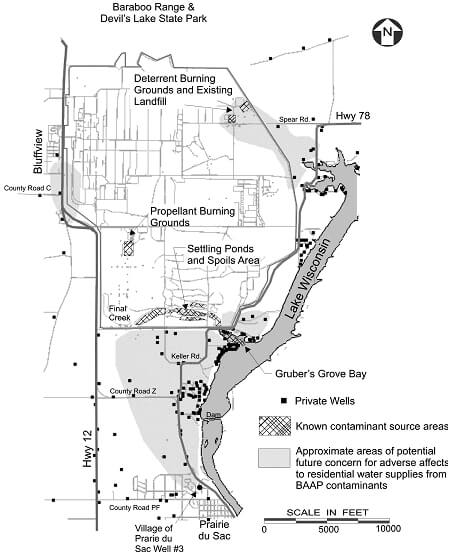Earlier this year, the Wisconsin Department of Natural Resources (WDNR) assured rural neighbors of Badger Army Ammunition Plant that their wells were free of the explosive dinitrotoluene (DNT). The WDNR said that the reported detections of the suspected human carcinogen were “false positives” – a conclusion that experts now say is inaccurate and misleading.
“I am critical of the use of the term ‘false positives’ because there is no real evidence of an interference or any other proof of false detects,” said Dr. Jerry Eykholt, an environmental engineer hired by the Badger Restoration Advisory Board to monitor cleanup activities at the closing base. “I believe the term is misleading, given the lack of any hard evidence or a specific reason that the detects could be considered false.”
Dr. Eykholt’s findings contradict notices sent to hundreds of residents living in an area extending from the Dairy Forage Research Center south to the northern edge of the Village of Prairie du Sac. In a January 10 letter, the WDNR said “of the more than eighty (80) private wells sampled as part of this study, DNT has been confirmed in four, and is currently present in only two wells.”
Because the initial tests were inconclusive, Dr. Eykholt believes it is possible that as many as 18 private drinking water supplies may still have low levels of DNT. Detected levels ranged from 0.01 to 0.08 parts per billion; the safe drinking water standard is 0.05 parts per billion. At least eight (8) private wells that had low levels of DNT are no longer being tested by the Army; 4 homes are located in the Windings subdivision; 2 are on Dam Heights Road; and 2 homes are in the Gruber’s Grove Bay neighborhood.
After the WDNR assured residents that DNT was “not present” in their wells, the Army discontinued providing free bottled water and many families resumed using their well water for cooking, drinking, and other household uses.
WDNR officials argue that Dr. Eykholt’s findings are irrelevant. Department representatives said that even if Eykholt is correct, previously detected levels are below state standards and therefore the water is safe to drink. “It would not change the Department’s response”, they said.
As it stands, the WDNR cannot assure the public that DNT is not present at low levels. “We don’t know, there is no way of checking, and there is no way to prove that there were false positives,” Dr. Eykholt emphasized. “Using the term ‘false positive’ can be a problem as a part of communication. There has to be proof that the DNT is not there.”
Sorting out whose well is truly clean or not has been made even more difficult because the WDNR recently allowed the Army to change water test methods. The new method for testing drinking water is less sensitive and is not capable of detecting the low levels that the old method could. In addition, the new method can only detect 2 forms (isomers) of DNT; the old method could detect four. The Wisconsin Division of Health supports a test method that can detect very low levels of DNT and that is capable of detecting all forms of the contaminant, but so far the WDNR has not enforced these recommendations.
The explosive DNT is not the only contaminant that has been detected in private wells near Badger. Low levels of 11 different contaminants were found in private wells, including ethyl ether – a chemical used in the manufacture of military propellants. The WDNR, however, said that it is no longer requiring the Army to monitor contaminant levels in the affected private wells because detected concentrations were well below drinking water standards.
Dr. Eykholt believes continued monitoring could be beneficial. “Ethyl ether and other contaminants might be important because it might be a leading edge of something else to come,” Dr. Eykholt told members of the Badger Restoration Advisory Board at their September 19 meeting. “You do need to look at other contaminants such as nitrates and ethyl ether because it might give us a better idea of where the (groundwater contaminant) plumes might be. The nitrates, for example, might be a better delineation of source areas and where the contamination might be coming from.”
Earlier this year, testing revealed that 2 homes in the Water’s Edge development on Gruber’s Grove Bay did have DNT concentrations above health standards. The Army has installed deeper wells for both families and so far DNT has not been detected in the replacement wells.
“There are no guarantees that the new wells (at the Water’s Edge Development) will not become contaminated,” WDNR officials told residents at a July 28 informational meeting at Badger. “We avoided getting into the bedrock where the water quality is not aesthetically good.”
The Army has also installed 3 groups of groundwater monitoring wells in the Water’s Edge neighborhood. DNT was detected above the safe standard in all of them. (Groundwater monitoring wells are not used to provide drinking water.) New groundwater monitoring wells are also planned for the Windings and Dam Heights subdivisions, just north of Prairie du Sac.
“Until the Army has restored groundwater quality, it is clear that nearby residential wells remain vulnerable,” said Laura Olah, Executive Director of Citizens for Safe Water Around Badger. “We will be meeting with local government boards and WDNR administrators to secure the reinstatement of private well testing and better test methods, and the enforcement of a contingency plan that will assure drinking water supplies are free of military toxins now and in the future.”


